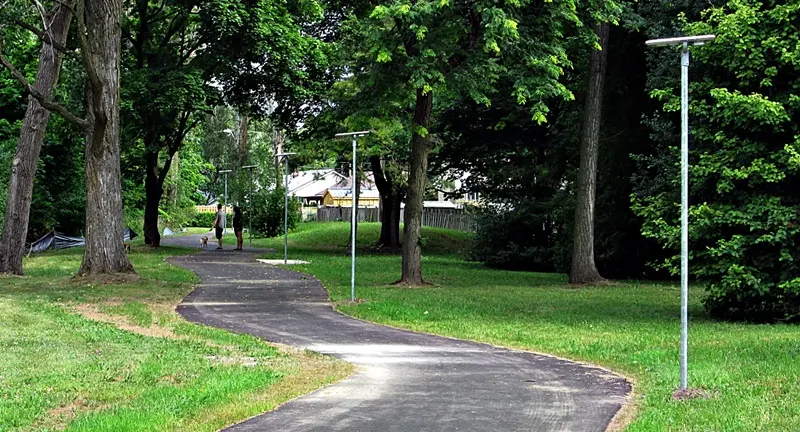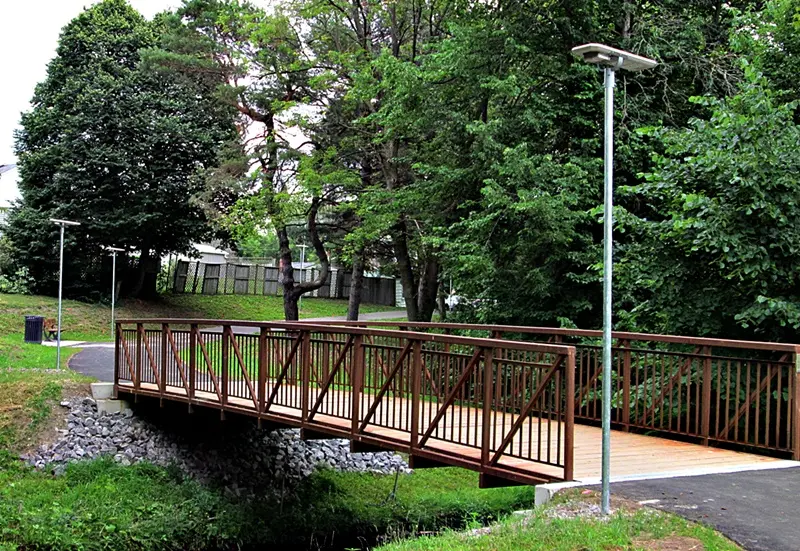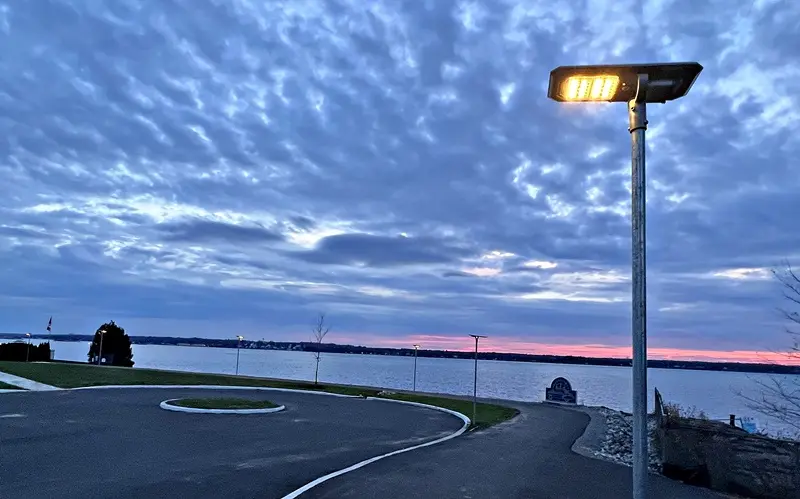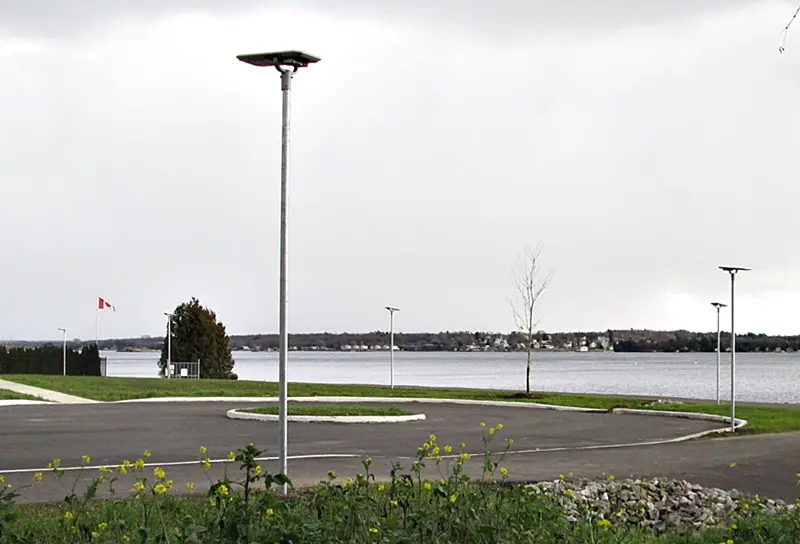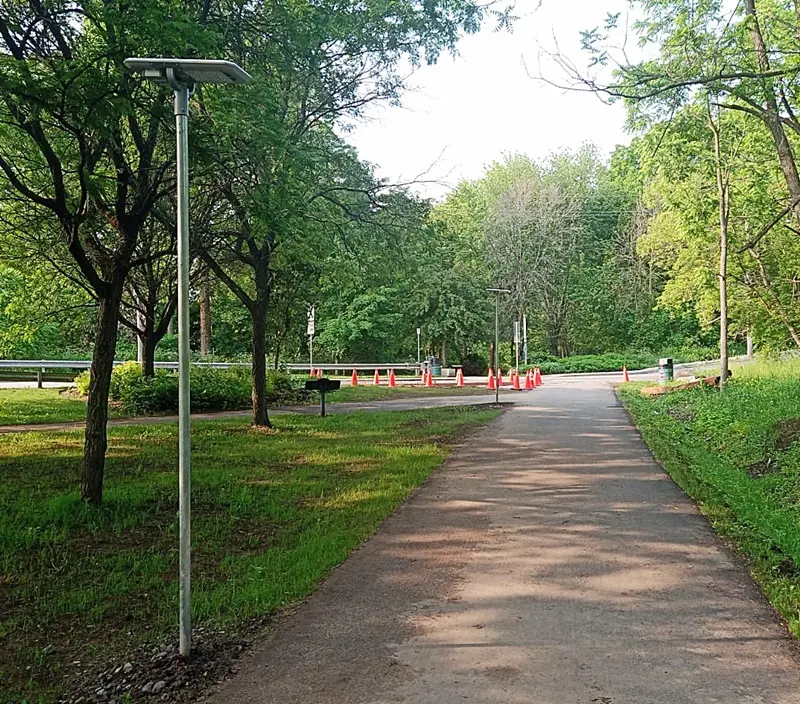In the picturesque coastal park of Canada, natural beauty coexists harmoniously with community life. However, providing safe and reliable lighting for residents during nighttime activities—without harming the fragile ecosystem or burdening the municipal grid—posed a formidable challenge. This article explores how the park successfully transformed this challenge into a model of sustainable development by deploying SRESKY Atlas Series integrated solar street lights, achieving a triple win in environmental, social, and economic benefits. As a global leader in solar lighting solutions, SRESKY has empowered countless projects with its innovative technology. This is not merely a lighting case study but a perfect fusion of technology and nature.
Part One: Project Background and Needs Analysis (The Challenge)
1.1 Site Overview: Unique Geographical and Climatic Challenges
The Canadian coastal city park, situated along either the Atlantic or Pacific shores, features distinctive geographical elements such as winding wooden boardwalks, meandering walking trails, and waterfront roads. These areas serve not only as popular leisure spots for citizens but also as ideal spaces for dog walking, jogging, and family gatherings. Spanning vast expanses with dense vegetation and diverse ecosystems—including wetland bird habitats and coastal vegetation belts—the park requires infrastructure upgrades that prioritize environmental conservation.
However, the maritime climate presents multiple challenges. High humidity and corrosive salt spray are constant threats, with sea winds eroding traditional metal equipment and increasing maintenance costs. More severe are Canada’s long, rainy, and overcast winters with limited daylight, sometimes lasting weeks with continuous snowfall or fog. This significantly reduces solar panel charging efficiency. Traditional solar lights often fail after extended cloudy periods, leaving areas unlit.
The park’s ecological sensitivity adds another layer of complexity. Its biodiversity requires infrastructure that minimizes disruption. Conventional streetlights demand trenching for cables, which damages soil structures and root systems, causing erosion and vegetation loss. As a result, the project team ruled out grid-based solutions from the outset, opting instead for a zero-excavation, zero-emission alternative.
1.2 Core Requirements: Safe, Green, and Efficient Lighting Solutions
The project’s primary goal was to enhance public safety. Uniform, ample illumination would mitigate hazards such as tripping or poor visibility, extending park usage into the evening and improving community wellness.
Sustainability was equally critical. In line with Canada’s “carbon neutrality” policies, the project required 100% clean energy. The system needed to operate reliably during long periods of rain or snow, withstanding temperatures as low as -20°C, while delivering stable, maintenance-free performance.
Finally, Total Cost of Ownership (TCO) had to remain low. Budget constraints required a system with reasonable upfront costs, minimal maintenance, and durable, easily replaceable components. These requirements clearly pointed toward advanced solar lighting technology, with the SRESKY Atlas Series providing the optimal solution.
Part Two: Technical Solution Design
2.1 Product Selection: Why Choose the SRESKY Atlas Series Solar Street Lights?
The SRESKY Atlas Series, with brightness options from 2000LM to 10000LM, met the park’s diverse needs. The SSL-32A (2000LM, 3m height, 15m spacing) was deployed on narrow pathways, while the SSL-310A (10000LM, 10m height, 32m spacing) illuminated wider roads. This precise allocation optimized lighting layouts while controlling costs.
The Atlas Series features an all-in-one design, integrating solar panels, lithium batteries, and LED chips in lightweight, durable aluminum alloy and PC housings. Its proven reliability is reflected in over 3,500 successful global projects.
2.2 Core Technology Adaptability Analysis
Hardcore Resilience Against Harsh Weather
To withstand Canada’s extremes, the Atlas Series employs patented systems. The ALS 2.2 Adaptive Lighting System intelligently adjusts brightness, ensuring illumination for more than 10 consecutive days of rain or overcast skies—eliminating the blackout risks of conventional solar lights.
The TCS Intelligent Temperature Control System optimizes charging between 0°C and 45°C, while ensuring stable discharging from -20°C to 60°C. This enables lithium-ion batteries to outperform standard LIFEPO4 cells in harsh winters.
Additional features include IP65 waterproofing, IK08 impact resistance, anti-rust brackets, and high-strength aluminum alloy construction. Monocrystalline silicon solar panels maintain efficiency even in low light.
The “Smart” Brain for Intelligent Management
The Atlas Series uses OSRAM LED chips with luminous efficacy up to 230lm/W, producing bright yet comfortable light. A PIR infrared sensor (120° angle, up to 8m range) enables adaptive lighting: Mode M1 provides 30% constant brightness and switches to 100% upon motion detection, saving energy while ensuring safety.
The Super Remote allows customized settings, monitoring battery and panel performance via app or PC. Hybrid power capability enables seamless AC backup when batteries fall below 30%, while resuming solar priority above 70%.
Part Three: Project Outcomes and Impact
3.1 Significant Economic and Environmental Benefits
The project achieved complete energy self-sufficiency, eliminating electricity costs. Its modular design simplifies component replacement, reducing maintenance expenses. With zero emissions, the system supports Canada’s carbon-neutral targets while reducing dependence on fossil fuels.
3.2 Enhanced Social Value and Community Well-being
Lighting upgrades greatly improved public safety. Residents reported greater peace of mind during evening walks and early runs. Extended park hours enhanced resource utilization, while the project gained recognition as a benchmark for sustainable urban development.
Part Four: Risks and Mitigation Strategies (Overcoming Obstacles)
4.1 Potential Risk: Extreme Weather Challenges
Snow accumulation may hinder solar charging. The Atlas Series mitigates this with ALS 2.2, offering over 10 days of backup power. Tilted solar panels also promote snow shedding.
4.2 Potential Risk: Vandalism
Public infrastructure often faces vandalism. The Atlas Series counters this with IK08-rated impact resistance and a reinforced aluminum alloy casing.
Conclusion
The Canadian Coastal Park Solar Streetlight Project represents not only a successful lighting upgrade but also a forward-looking model for future public infrastructure. By adopting the advanced and resilient SRESKY Atlas Series, the project addressed the challenges of lighting in environmentally sensitive areas while proving solar technology’s ability to perform reliably in extreme climates. Its social, environmental, and economic benefits provide valuable lessons for other cities and parks worldwide pursuing green, safe, and intelligent lighting solutions.
